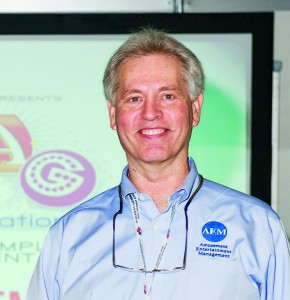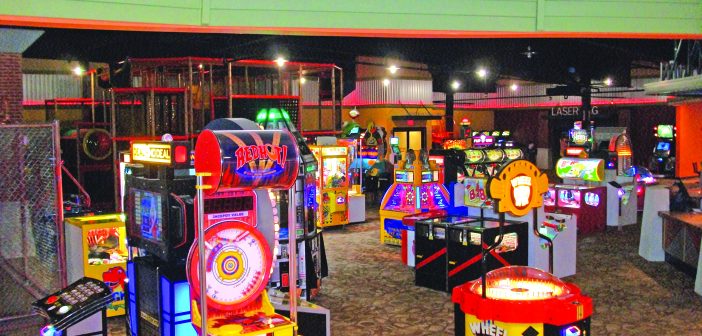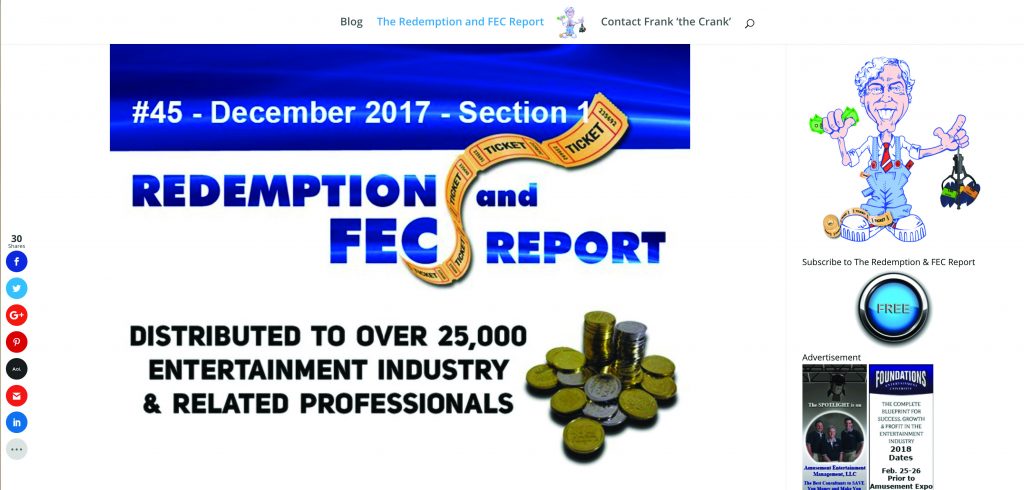What’s Hot…And What’s Not – Part Three
Using Game Trends & New Ideas in Promotions to Heat Up Revenues

Frank Seninsky
by Frank Seninsky, President/CEO Amusement Entertainment Management (AEM) & Alpha-Omega Amusements & Sales
Let’s start by talking about new equipment. New games are coming out at a pretty fast pace. What I’ve noticed about the manufacturing industry –– and the Alpha-Omega Group was just having this debate the day I wrote this column –– is that when a manufacturer comes up with a game that has some “buzz,” its concept is almost immediately replicated by several other manufacturers in the industry.
Everyone wants to jump on the band wagon with the least amount of research and development cost. The race is on to sell a hundred games, which today is considered a success. Patent infringement doesn’t seem to be a big consideration anymore; it is practically non-existent outside of North America. Lawsuits are expensive, especially with some foreign manufacturers knocking off everything. (Obviously I believe in patents, and in some cases, the patent holder can and does win infringement cases with large judgments. I am not encouraging copying.)
The world is tough, but success is attainable. In today’s highly competitive business climate, we know now that people really only want to buy the best of the best. To get great games into the market, distributors are still very important. They (in conjunction with manufacturers and/or finance companies) have copied the auto industry and come up with enticing financing programs like “zero down and zero interest” for even up to a year. And the game operators are taking a shot at it since it appears they have little to lose. Leasing is also a great idea, and has helped many game operators and family entertainment center owners upgrade their game zones and raise the bar.
However, in some cases the games that are chosen are not necessarily the best choices. So, the Latin phrase we were taught in junior high, “caveat emptor” – “buyer beware” is still relevant and always applies. (This is perhaps the only Latin phrase I know and it has helped me several times per day, every day.)
How to Buy the Best
If you look at where a game ranks on my Redemption & FEC Report (it’s free and found at www.frankthecrank.com), and how that game’s revenue has dropped or remained steady over a period of time, you can learn a lot. I think it’s the best tracker of game trends.
The more I dive in, the more I learn, but sadly, too many people don’t take the time. They just look at it and say, “Okay, here are the top games. I’ll buy one of them soon.” That’s okay if that’s what helps them make a better equipment-buying choice. But in most cases, some other expense comes up unexpectedly and that fire needs to be put out. (I call that business philosophy, “chasing your tail.”)
You can learn more by dividing all of the games’ weekly revenues by the current value of that game (the price you can sell it for in “as is” working condition), and then ranking the results. This “rubber band” ratio ranking (I named it many years ago) closely resembles “return on investment” for each game. It’s actually a whole different chart that takes the AEM team another 12 hours to develop every week, but that’s basically what you’re talking about.
What it shows is that you can make a better return on a game that makes $100 a week that is currently valued at $2,000 ($100/$2,000 = 0.05) for example, as opposed to a newly purchased $12,000 game that’s grossing $500 dollars a week or five times as much ($500/$12,000 = 0.04).
Other trends I see with equipment is how operators cram them into game zones (and the wrong kind of rooms on top of it) thinking more games equals more revenue. Just adding more games per square foot does not equal more revenue per square foot. That kind of game layout is definitely not hot.
I can literally just remove several low-earning or large-footprint games from a game room and the total revenue goes up anywhere from 15 to 25 percent. You read that right. This increase is created without doing anything more than widening the entrance and giving the guests more space to meander through the games area without bumping into other spectators or players.
I design game zones at 50 square feet per game and always have enough space to have an opportunity to maximize revenues, and also to give the guests a better experience.
I also use “dynamic clusters” of no more than four games (it could be two games back-to-back, three in a triangular arrangement, four arranged with two back-to-back and side-to-side, or a multi-player single game like Cyclone, Wizard of Oz or DC Superheroes). But, never more than four. I also strategically place bill changers, kiosks, small merchandisers on the end caps of two games back-to-back of similar height and width.
By using dynamic clusters in game zones across the world, I can tell you that approximately 80 percent of the game revenues are generated from the game clusters in the middle of the floor. (Read more about this, what pieces should be on the perimeter and other tips on maximizing game room revenue in the February 2016 Frank Talk. You can read it online at www.replaymag.com/frank-talk-february-2016.)
New Ideas for Promotions & Marketing
Clearly game selection and layout are key to your success, but if you really want to maximize revenue, you’ll want to focus on what’s hot in promotions and marketing.
Here’s what might be a startling concept for you: The best marketeers of your facility can be your employees. If you don’t cross train them and teach them how and why your business operates as it does, you are wasting a tremendous opportunity.
Hint: In order to motivate them to promote and market your facility, they have to believe they are a part of your team and actually benefit from it. They have to understand the big picture of the whole business and often that means sharing financial information with the key staff.
Let me share a story to illustrate my point. I walked into a center where I had a nine o’clock appointment with the owner. There was only one staff person there preparing to get the front desk set up before the 10 am opening. I announced myself and said I was early and would she mind if I walked around. We started to chat. She tells me she’s been with the company for more than 30 years and really loves her job.
And then the phone rings. She picks it up and I could tell that it was someone that was inquiring about a birthday party. She said something like, “The birthday party host person doesn’t get in until 11. Could you please call back then?” And she hung up.
“Wow, that’s interesting,” I said. “How do you know that person’s going to call back?” She replied, “I don’t really care.” Dumbfounded, I asked, “May I ask why?”
She asked if I really wanted to know and when I said I did, she explained, “Well, we have four people who work for me at the front desk. The birthday party people –– all of the hostesses, those who book the parties, and even the cooks in the kitchen are all included in the birthday party tip pool. None of the front desk people, including me, are included in that tip pool.”
“Wow,” I said. I asked her how big this tip pool got, thinking it must be a big deal. She said, “We get paid every two weeks so it could be anywhere from four to eight dollars.” She must have seen the puzzled look when I bit my lip and continued, “Well, that may not seem like a lot,” but it means a lot to us. We don’t give a #*$! about the birthday parties around here.”

I brought this up very delicately with the owner later that day, but not as it related specifically to birthday parties and the tip pool: “Are you aware that you’ve got infighting here among your general managers and the front staff? I can see why the front staff doesn’t report when the games are out of order in the game room. If they get a complaint, it’s easier for them to just go out and put an out of order sign on it. Why would they ever call it in? They’re not tied into the games’ success.”
The owner and I worked out a method to get the entire center staff interested in the games operation and reporting systems. While doing this, the owner mentioned to me that there is a tip pool that currently does not include the front desk staff and he thinks it would be a good idea to include them in it. I nodded and quickly agreed and so it was done. End of story.
Rewards other than being able to participate in a tip pool abound at a fun center. See the sidebar above for just a few ways you can reward your employees and make them feel like a valuable part of the team that they truly are.
Promotions
Let’s talk about business philosophy. What business are we really in? Some may say the “leisure out-of-home entertainment industry.” That’s true, but we’re also in the “repeat visit business.”
In drilling down attendance data at family entertainment centers, it’s astounding that approximately 50 percent of our customers come only once and then never ever come again. These are known as “one and done.” (Reasons could be: they attend a birthday party or group event, but cannot afford a return visit; one or more members of their group had a bad experience; they moved out of the area, they latched on to a competitor’s VIP program, etc.) This also means that the remaining half of the individual customers come two, three, four, or even more times per year and are indeed loyal customers.
With this knowledge, it makes logical sense that we should be focusing on promotions to get each one of our current customers to visit one additional time per year and to bring a new person with them! We must think of each customer not in terms of how much they spend per visit, but rather the total that they spend on multiple visits per year. That means that we must not have them spend more than the area’s natural internal per capita spending amount per visit.
What we do is basically throw the deal book at them!
Value Package Deals
The concept is to make sure that each one of your customers has a good, two-hour experience and doesn’t run out of money too quickly. To accomplish this, you are basically selling “time” and collecting the average per capita spending amount. In return, the customer feels they are getting a great deal and receiving an across the board discount.
Example package: Laser tag (two games), bumper cars, $5 game card for $15. The posted a la carte individual pricing is: laser tag at $8 per game and bumper cars at $3, so with that $5 game card, the package value is $24; the value package saves the customer $9.
Any attraction package should include a game card (or handful of tokens) because that’s one of your lowest cost of sales. Redemption games also help bring people back, because they save their points. It’s easy to get repeat visitation from bounce backs, returning and bringing a friend, and so on, giving the friends the benefits of the discounts.
Tipping the Customer … Say What?!
I recently read an article on how to “tip” the customer. What that means is actually giving them an incentive –– or paying them –– to try a new product or service (like a free sample) and then try to upgrade them to a higher-level product. That’s how retail used to be done in the ’20s and ’30s, so it’s very interesting to tie that in to current practices and ask, “How does that market our industry?”
This is actually the underlying principal of a VIP program. You are rewarding your top customers by giving them an upfront “tip” (reward), on-going discounts on your attractions and services, all to keep them coming back to spend some money with each visit.
Be careful how you do this though. I visited one bowling center that was paying people 25 cents per game to come in and bowl during the week in the summer. Additionally, they lowered the hot dog price to $2 each and also discounted beer prices. The idea was to draw in a crowd and see how much additional money each customer would spend. This worked well initially, but the downside is that the customers got used to this pricing and then when September came around, they didn’t bowl as often, perhaps waiting for summer to come again.
So while we focus on what trends are hot (or not) in the amusement business, there’s nothing hotter than best operating practices:
• Pay attention to game purchases, making sure you’re really looking at the value of each piece, not just the money in the cashbox.
• Evaluate your game room layout to see if you are your own worst enemy by packing it so full of games and attractions that your players and spectators can’t easily move across the floor.
• Make sure each employee feels valued and is rewarded in ways that make them buy into your success.
• Find ways to reward your customers so they visit your center more times per year than they already do, and get them to bring friends with them.
Promotions that work internally are the best, but again, it takes a little staff cross training, staff incentives, and, of course, education as to why their jobs are important to the business’ success. You can do this!
(For more information about game trends, promotions, marketing ideas and VIP programs, contact Frank at fseninskyaem@ gmail.com or call his cell: 732-616-5345.
Frank Seninsky is president of the Alpha-Omega Group of companies, which includes a consulting agency (Amusement Entertainment Management), two nationwide revenue-sharing equipment suppliers (Alpha-Omega Amusements and Alpha-BET Entertainment), and Alpha-Omega Sales, a full-line game and related equipment distributor. During his 47 years in the leisure entertainment industry, Seninsky has presented nearly 400 seminars and continues to regularly write columns in numerous trade publications. He served as president of the AMOA (and was on the board for 22 years), and was president of IALEI (founding member and on the board for 11 years). Frank is the sole owner of Foundations Entertainment University, now in its 16th year. He is also considered a leading industry expert in the design, layout, and operations of coin-/debit card-operated arcades and FEC attractions, and is often called upon as an expert witness in cases involving the amusement industry. Frank edits The Redemption & FEC Report e-newsletter (35,000+ readers worldwide) and also writes a blog at www. frank-thecrank.com. Frank can be reached by phone at 732- 616-5345 or by email at fseninskyAEM@gmail.com (website: www.AEMLLC.com).






1 Comment
Pingback: What’s Hot…And What’s Not –– Part Three - Frank 'the Crank' Seninsky Blog